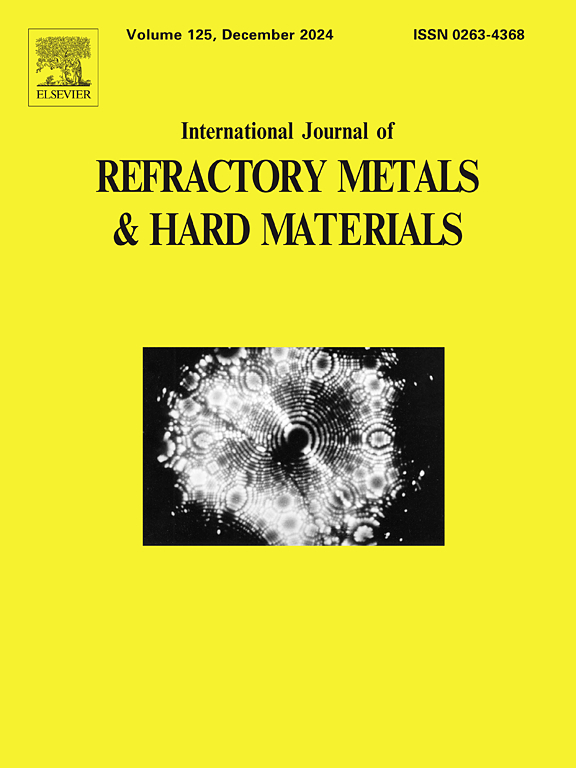Electrochemical corrosion behavior of WC-Co and WC-Ni cemented carbides: Effect of chloride and sulfate ions
IF 4.2
2区 材料科学
Q2 MATERIALS SCIENCE, MULTIDISCIPLINARY
International Journal of Refractory Metals & Hard Materials
Pub Date : 2025-05-10
DOI:10.1016/j.ijrmhm.2025.107224
引用次数: 0
Abstract
In this work, the influence of chloride and sulfate ions on the corrosion behavior of WC-Co and WC-Ni cemented carbides is investigated using open circuit potential monitoring, potentiodynamic polarization, electrochemical impedance spectroscopy, and surface analytical techniques. Results reveal that the corrosion resistance of WC-Co cemented carbide is significantly compromised in the presence of chloride ions, with more negative corrosion potentials and higher corrosion current densities compared to the alloy in presence of sulfate ions. In contrast, due to its lower corrosion sensitivity, WC-Ni cemented carbide exhibits only slight dissolution behavior in both media, especially in the less aggressive sulfate-containing environment, where it demonstrates an outstanding corrosion resistance. WC-Ni cemented carbide also displays higher polarization charge transfer resistance than WC-Co counterparts. This is primarily attributed to the stable passivation layer of the WC-Ni hardmetal surface, which slows the charge transfer at the interface, impeding the oxidative reaction processes and effectively preventing corrosion. This different corrosion response is supported by small-scale hardness changes observed in WC-Co and WC-Ni cemented carbides, after corrosive immersion of both materials, especially in chloride-containing environments.
WC-Co和WC-Ni硬质合金的电化学腐蚀行为:氯离子和硫酸盐离子的影响
在这项工作中,氯离子和硫酸盐离子对WC-Co和WC-Ni硬质合金腐蚀行为的影响采用开路电位监测、动电位极化、电化学阻抗谱和表面分析技术进行了研究。结果表明,在氯离子存在下WC-Co硬质合金的耐蚀性明显降低,与硫酸盐离子存在下的合金相比,WC-Co硬质合金具有更多的负腐蚀电位和更高的腐蚀电流密度。相比之下,由于其较低的腐蚀敏感性,WC-Ni硬质合金在两种介质中仅表现出轻微的溶解行为,特别是在腐蚀性较低的含硫酸盐环境中,它表现出出色的耐腐蚀性。WC-Ni硬质合金的极化电荷转移电阻也高于WC-Co硬质合金。这主要是由于WC-Ni硬质合金表面的稳定钝化层,减缓了界面处的电荷转移,阻碍了氧化反应过程,有效地防止了腐蚀。WC-Co和WC-Ni硬质合金在腐蚀浸泡后,特别是在含氯环境中,观察到的小尺度硬度变化支持了这种不同的腐蚀响应。
本文章由计算机程序翻译,如有差异,请以英文原文为准。
求助全文
约1分钟内获得全文
求助全文
来源期刊
CiteScore
7.00
自引率
13.90%
发文量
236
审稿时长
35 days
期刊介绍:
The International Journal of Refractory Metals and Hard Materials (IJRMHM) publishes original research articles concerned with all aspects of refractory metals and hard materials. Refractory metals are defined as metals with melting points higher than 1800 °C. These are tungsten, molybdenum, chromium, tantalum, niobium, hafnium, and rhenium, as well as many compounds and alloys based thereupon. Hard materials that are included in the scope of this journal are defined as materials with hardness values higher than 1000 kg/mm2, primarily intended for applications as manufacturing tools or wear resistant components in mechanical systems. Thus they encompass carbides, nitrides and borides of metals, and related compounds. A special focus of this journal is put on the family of hardmetals, which is also known as cemented tungsten carbide, and cermets which are based on titanium carbide and carbonitrides with or without a metal binder. Ceramics and superhard materials including diamond and cubic boron nitride may also be accepted provided the subject material is presented as hard materials as defined above.

 求助内容:
求助内容: 应助结果提醒方式:
应助结果提醒方式:


